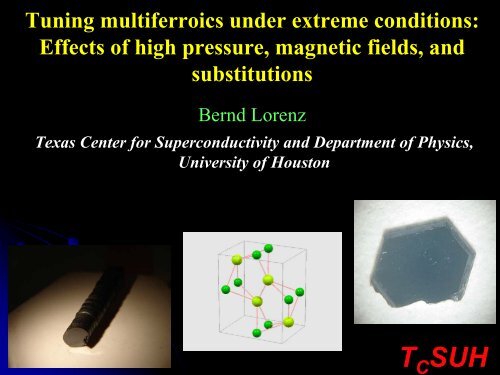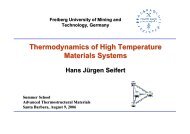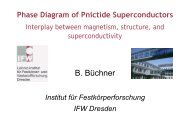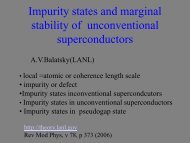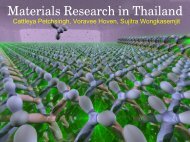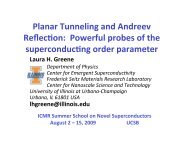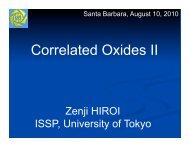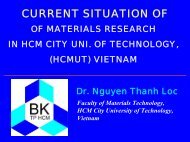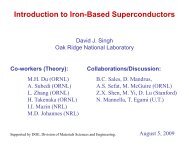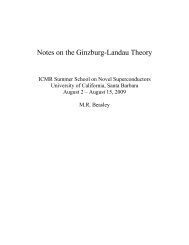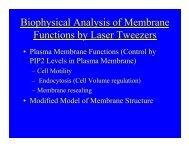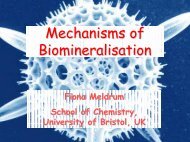Effects of high pressure, magnetic fields, and substitutions - ICMR ...
Effects of high pressure, magnetic fields, and substitutions - ICMR ...
Effects of high pressure, magnetic fields, and substitutions - ICMR ...
Create successful ePaper yourself
Turn your PDF publications into a flip-book with our unique Google optimized e-Paper software.
Tuning multiferroics under extreme conditions:<br />
<strong>Effects</strong> <strong>of</strong> <strong>high</strong> <strong>pressure</strong>, <strong>magnetic</strong> <strong>fields</strong>, <strong>and</strong><br />
<strong>substitutions</strong><br />
Bernd Lorenz<br />
Texas Center for Superconductivity <strong>and</strong> Department <strong>of</strong> Physics,<br />
University <strong>of</strong> Houston<br />
T C SUH
Outline<br />
1) Short introduction: Multiferroics (MF)<br />
2) Helical <strong>magnetic</strong> order, exchange striction, <strong>and</strong> double<br />
exchange as the source <strong>of</strong> ferroelectricity<br />
3) The significance <strong>of</strong> magnetoelastic effects <strong>and</strong> spin-lattice<br />
interaction – how to detect them in MF<br />
4) The effects <strong>of</strong> <strong>high</strong> <strong>pressure</strong> on the MF phases <strong>and</strong><br />
ferroelectricity<br />
5) Tuning MF properties by ionic <strong>substitutions</strong><br />
6) Summary
1. Short introduction: Multiferroics<br />
Multiferroic :<br />
Materials showing <strong>magnetic</strong> (FM, AFM) <strong>and</strong> ferroelectric (FE) orders coexisting in<br />
some temperature range <strong>and</strong> a sizable coupling between them.<br />
Eerenstein, Nature 2006<br />
Materials are rare since two fundamental symmetries have to be broken:<br />
Time reversal symmetry (<strong>magnetic</strong> order) <strong>and</strong><br />
Spatial inversion symmetry (ferroelectric order)
Important role <strong>of</strong> frustration:<br />
Note:<br />
If Humans get frustrated .....<br />
they <strong>of</strong>ten don’t know what to do .....<br />
<strong>and</strong> a small perturbation can change their mood<br />
The same “rules” apply to frustrated physical systems<br />
Examples <strong>of</strong> frustrated orders:<br />
1. Geometric frustration<br />
?<br />
AFM spins on a triangular lattice<br />
are frustrated =><br />
Noncollinear order, spin rotations,<br />
complex phase diagrams<br />
(HoMnO 3 )
2. Frustration due to competing interactions<br />
AFM<br />
E-type<br />
J 1<br />
>0 J 2<br />
>0<br />
Ground state energy (Ising limit):<br />
AF: N (J 2<br />
-J 1<br />
)<br />
In a simple Ising (Heisenberg) model<br />
<strong>of</strong> spins with AFM/FM first <strong>and</strong> AFM<br />
second neighbor interaction there is<br />
frustration <strong>and</strong> degeneracy near<br />
J 1<br />
=2J 2<br />
E-type: - N J 2<br />
Transition from AF to E-type at J 1<br />
= 2 J 2<br />
Same arguments hold for J 1<br />
< 0 (FM to E-type)<br />
This results in a complex phase<br />
diagram at T>0 with many<br />
commensurate <strong>and</strong> incommensurate<br />
phases<br />
The devil’s tree <strong>of</strong> the Ising<br />
model
Competing interactions in RMnO 3<br />
O<br />
Magnetic phase diagram <strong>of</strong> orthorhombic<br />
RMnO 3<br />
Mn<br />
a<br />
b<br />
R<br />
Superexchange couplings Mn 3+ -O -Mn 3+ :<br />
J 1 0 (AFM)<br />
depend on bond angle Φ (Mn-O-Mn), which is<br />
controlled by size <strong>of</strong> R<br />
Frustration <strong>and</strong> “exotic” phases near Φ ≈145 deg
Novel physical effects in multiferroic compounds:<br />
Ferroelectricity induced by <strong>magnetic</strong> orders ( e.g. TbMnO 3<br />
, Ni 3<br />
V 2<br />
O 8<br />
, MnWO 4<br />
)<br />
Rotation <strong>of</strong> FE polarization by 90˚ in <strong>magnetic</strong> <strong>fields</strong> ( TbMnO 3<br />
, MnWO 4<br />
)<br />
Complete reversal <strong>of</strong> FE polarization by <strong>magnetic</strong> <strong>fields</strong> ( TbMn 2<br />
O 5<br />
)<br />
Giant magneto-dielectric effect in DyMn 2<br />
O 5<br />
(increase <strong>of</strong> dielectric constant by more than 100 % in <strong>magnetic</strong> <strong>fields</strong>)<br />
Ferro<strong>magnetic</strong> order induced by electric <strong>fields</strong> ( HoMnO 3<br />
)<br />
<br />
<br />
Complex <strong>magnetic</strong> phase diagrams with incommensurate <strong>and</strong> commensurate<br />
<strong>magnetic</strong> structures, lock-in transitions, <strong>and</strong> multicritical points<br />
Experimental discovery <strong>of</strong> a new excitation - electromagnons<br />
. . . . .
Experimental discovery <strong>of</strong> a new fundamental excitation – The electromagnon<br />
Theoretically predicted in 1970:<br />
<br />
Hybrid excitation <strong>of</strong> a phonon <strong>and</strong> a magnon<br />
due to strong spin-phonon coupling<br />
Low-energy excitation (10 ... 20 cm -1 ) predicted in optical experiments<br />
(electric field can excite a magnon)<br />
magnon<br />
phonon<br />
Experimentally confirmed<br />
in 2006 in different multiferroic<br />
compounds:
2. Helical <strong>magnetic</strong> order, exchange striction, <strong>and</strong><br />
double exchange as possible sources <strong>of</strong> FE<br />
Search for common features (<strong>magnetic</strong> orders) in different MF compounds:<br />
The important role <strong>of</strong> neutron scattering experiments as the key investigation<br />
TbMnO 3<br />
HT IC order <br />
sinusoidal modulation<br />
LT IC order <br />
helical (spiral)<br />
modulation<br />
(spatial inversion<br />
symmetry is broken)
Ni 3 V 2 O 8<br />
Magnetic frustration is due to the<br />
geometry (kagome) with AFM exchange<br />
Only LTI phase is<br />
ferroelectric !<br />
HT IC order <br />
sinusoidal modulation, inversion symmetry<br />
LT IC order <br />
helical (spiral) modulation, no IS<br />
Commensurate order <br />
sinusoidal modulation, inversion symmetry
WMnO 4<br />
Frustration due to competing intrachain<br />
interactions (FM / AFM)<br />
Same phase sequence:<br />
PM → Coll. ICM AF3<br />
→ Helical ICM AF2 (ferroelectric)<br />
→ Coll. CM AF1 ( ↑↑↓↓ )<br />
Very different compounds <strong>and</strong><br />
structures reveal similar phenomena:<br />
Ferroelectricity arising in a spiral<br />
<strong>magnetic</strong> phase The microscopic<br />
origin <strong>of</strong> FE is the symmetry <strong>of</strong> the<br />
<strong>magnetic</strong> order (breaking the spatial<br />
inversion)
FE polarization induced by non-collinear helical spins<br />
Katsura et al., PRL 2005<br />
Spin-orbit coupling partially lifts the degeneracy<br />
<strong>of</strong> the Mn 3+ d-orbitals (t 2g )<br />
Hopping Mn ↔ O is treated perturbatively in<br />
second order<br />
Polarization <strong>of</strong> electronic orbitals :<br />
r r r r<br />
P ~ e × e<br />
12<br />
( e × )<br />
1<br />
2<br />
spin current<br />
Considered oxygen displacement at FE transition<br />
due to Dzyaloshinskii-Moriya interaction<br />
DM interaction does stabilize the helical spin<br />
structure <strong>and</strong> the oxygen displacements resulting<br />
in the FE polarization<br />
Sergienko/Dagotto, PRB 2006
Symmetry <strong>and</strong> L<strong>and</strong>au theory (Kenzelmann, Mostovoy)<br />
Lowest order coupling Φ em<br />
(P,M) between FE polarization, P, <strong>and</strong> <strong>magnetic</strong><br />
modulation, M, that is invariant upon time reversal <strong>and</strong> spatial inversion:<br />
t -> -t : P -> P <strong>and</strong> M -> -M Φ em<br />
quadratic in M<br />
x -> -x: P -> -P <strong>and</strong> M -> M Φ em<br />
~ P <strong>and</strong> ∇M (Lifshits invariant), P uniform<br />
for cubic symmetry: Φ em<br />
= const P* [ M(∇*M) – (M*∇)M ]<br />
Φ e<br />
= P 2 /(2χ e<br />
) =><br />
P = const χ e<br />
[ M(∇*M) – (M* ∇)M ]<br />
Spiral <strong>magnetic</strong> order: M = m 1<br />
e 1<br />
cos(Qx) + m 2<br />
e 2<br />
sin(Qx) + m 3<br />
e 3<br />
Average polarization: = const χ e<br />
m 1<br />
m 2<br />
[ e 3<br />
× Q ]<br />
Sinusoidal <strong>magnetic</strong> order: m 1<br />
or m 2<br />
=0 => = 0
FE polarization induced by exchange striction <strong>of</strong> frustrated spins<br />
Two frustrated spins tend to separate to reduce<br />
<strong>magnetic</strong> exchange energy<br />
Applies to: E-type (↑↑↓↓) <strong>magnetic</strong> order due to<br />
competing NN <strong>and</strong> NNN interactions<br />
If the associated ions have different charges =><br />
local polarization <strong>of</strong> the lattice<br />
Can add up to macroscopic polarization <strong>and</strong><br />
ferroelectricity<br />
No need <strong>of</strong> non-collinear spin order<br />
Cheong/Mostovoy, Nature Mat. 2007<br />
Examples:<br />
Ising chain magnet Ca 3<br />
CoMnO 6<br />
(Choi et al., PRL 2008)<br />
RMn 2<br />
O 5<br />
(R = rare earth, Y, Bi)<br />
but not RMnO 3<br />
with E-type <strong>magnetic</strong> order (HoMnO 3<br />
)<br />
- no charge order
Ferroelectricity due to possible exchange striction effects in<br />
RMn 2 O 5<br />
Magnetic structure from neutron scattering<br />
Superexchange interactions determine<br />
exchange parameters between Mn<br />
spins<br />
Mn 4+<br />
At least 5 different exchange integrals<br />
can be distinguished ⇒ Mostly AFM<br />
Mn 3+<br />
Ionic displacements relax the<br />
<strong>magnetic</strong> frustration <strong>and</strong><br />
generate the polarization along<br />
the b axis<br />
c<br />
b<br />
a<br />
P
Ferroelectricity in Multiferroics with E-Type Magnetic Order<br />
(Theory – Double exchange model)<br />
E-type <strong>magnetic</strong> order in RMnO 3<br />
:<br />
Sergienko/Dagotto, PRL 2006:<br />
R = Ho<br />
“Double-exchange” (virtual) mechanism works<br />
against Jahn-Teller distortion in FM spin<br />
chains along a-axis<br />
Does not involve DM interaction<br />
Large FE polarization predicted<br />
Problems:<br />
Experimental – only polycrystalline samples<br />
can be synthesized (<strong>high</strong>-<strong>pressure</strong> synthesis)<br />
Theoretical – predicted polarization is three<br />
orders <strong>of</strong> magnitude larger than measured<br />
Dual nature <strong>of</strong> FE (electronic + ionic) recently<br />
suggested (Picozzi et al., PRL 2007)<br />
P (μC/m 2 )<br />
a<br />
ΔE ~ - t 2 /δ cosΦ Mn-O-Mn<br />
15<br />
10<br />
5<br />
b<br />
P<br />
T NC<br />
0<br />
0 10 20 30<br />
T (K)<br />
T L<br />
H=0<br />
5 kOe<br />
15 kOe<br />
20 kOe<br />
25 kOe<br />
35 kOe<br />
Pbnm
2. Magnetoelastic effects <strong>and</strong> spin-lattice coupling<br />
– how to measure these effects ?<br />
In multiferroics the spin-lattice interaction plays a decisive role in mediating the<br />
(improper) ferroelectricity induced by <strong>magnetic</strong> orders<br />
The measurements <strong>of</strong> the ionic displacements <strong>and</strong>/or the macroscopic lattice strain<br />
is therefore <strong>of</strong> interest<br />
Scattering experiments (x-ray, neutron) provide the tool to measure displacements<br />
on a microscopic level – but <strong>of</strong>ten lack the resolution to detect the tiny changes.<br />
Note: The atomic displacements explaining the experimental values <strong>of</strong> the FE<br />
polarization are as small as 10 -4 Å.<br />
Only a few attempts to derive structural distortions at the <strong>magnetic</strong> <strong>and</strong> ferroelectric<br />
transitions in multiferroics have been successful.
Capacitance dilatometer for <strong>high</strong>-resolution measurements <strong>of</strong> lattice strain<br />
(i) Capacitance can be measured with extreme accuracy (~ 10 -8 )<br />
(ii) Measuring the absolute length change <strong>of</strong> a<br />
macroscopic sample can further increase<br />
the relative resolution in proper geometry <strong>of</strong><br />
the device
Structural distortions in multiferroic (hex.) HoMnO 3<br />
Growth <strong>of</strong> <strong>high</strong>-quality single crystals from <strong>high</strong>-T solution (right)<br />
<strong>of</strong> through a floating zone furnace.<br />
Compound is multiferroic with T C > T N<br />
Magnetic order on triangular lattice is <strong>high</strong>ly frustrated<br />
Ferroelectric at 870 K<br />
Polarization along c-axis<br />
Z = 0<br />
AFM ordering at T N =76 6 K<br />
Mn 3+ Magnetic moments<br />
long-range ordering<br />
?<br />
in the ab-plane<br />
(P6’ 3 c’m)<br />
a<br />
Z = C/2<br />
b<br />
Mn 3+ moments undergo a spin<br />
rotation at T SR =33 K into the P6’ 3 cm’<br />
symmetry<br />
Mn 3+ moments rotate into the<br />
P6 3 cm structure at 5 K
Dielectric Anomalies at the Magnetic Transitions <strong>of</strong> HoMnO 3<br />
P6’ 3<br />
cm’<br />
P6’ 3<br />
c’m<br />
P6 3<br />
cm
Dielectric Anomaly at <strong>and</strong> below T N<br />
(common to all hexagonal RMnO 3 )<br />
No direct coupling between c-axis<br />
polarization <strong>and</strong> in-plane magnetization<br />
allowed by symmetry<br />
Magneto-dielectric coupling via<br />
lattice deformation (magnetoelastic<br />
effect)<br />
Strong spin-lattice interactions<br />
required<br />
Search for structural<br />
anomalies or lattice strain
Thermal Expansion Anomalies in HoMnO 3 (<strong>and</strong> YMnO 3 )<br />
Strong anomalies at T N<br />
:<br />
20<br />
a (b) -axis shrinks c-axis exp<strong>and</strong>s<br />
a-axis<br />
Negative c-expansivity for all T
Strong spin-spin <strong>and</strong> spin-lattice coupling in RMnO 3<br />
In-plane Mn-Mn superexchange interactions are very strong<br />
Model description:<br />
AFM long range order is suppressed due to frustration <strong>and</strong> weak inter-plane exchange<br />
Sizable spin-spin correlations well above mT N<br />
growing estronger for decreasing me T→T N<br />
H = H + H +<br />
(evidence from magnetization <strong>and</strong> neutron scattering, Lonkai et al. J. Appl. Phys. 93, 8191, 2003)<br />
Magnetostriction (spin-lattice coupling) leads to a shortening <strong>of</strong> in-plane distances with<br />
m<br />
// z z ⊥ x x y y<br />
// z z ⊥ x x y y<br />
z<br />
decreasing H T = <strong>and</strong>, 2 ( Jvia s lattice s + J elasticity, ( s s + s s to ) −the 2αincrease J s s <strong>of</strong> + Jthe ( sc-axis s + s length s ) − h s<br />
∑<br />
i,<br />
j<br />
i<br />
j<br />
i<br />
j<br />
i<br />
j<br />
N<br />
These effects are dramatically enhanced at T N<br />
(peaks <strong>of</strong> α a<br />
<strong>and</strong> α c<br />
with opposite signs)<br />
15.6<br />
0.9995<br />
2<br />
Magnetic subsystem<br />
Through the e spin-lattice ⎛ P interaction ⎞<br />
i<br />
a 2 b 4 the spin fluctuations couple with the FE<br />
H =<br />
displacement ∑coordinate<br />
⎜ − u +<br />
⎟ −<br />
i<br />
ui<br />
∑Uui<br />
u<br />
j<br />
−∑Eui<br />
i ⎝ 2m<br />
2 4<br />
15.4<br />
⎠ i,<br />
j<br />
i<br />
Ferroelectricity<br />
H<br />
me<br />
=<br />
z z x x y y<br />
( g s s + g ( s s s s<br />
)<br />
2<br />
∑ uk<br />
1<br />
+<br />
i j 2 i j<br />
k,<br />
i,<br />
j<br />
i<br />
j<br />
H<br />
∑(<br />
15.8<br />
) ∑<br />
i l i l i l<br />
i,<br />
l<br />
ε<br />
16.2<br />
16.0<br />
T SR<br />
T T<br />
2<br />
T N<br />
0 50 100<br />
T (K)<br />
Spin-lattice coupling<br />
ε ∼ 1/ 2 scales with 1/c 2<br />
C. Zhong <strong>and</strong> J. Fang Solid State Comm. 128, pp449 (2003)<br />
i<br />
i<br />
1.0005<br />
1.0000<br />
[c(T)/c(293 K)] -2
Structural distortions <strong>and</strong> ferroelectricity in RMn 2 O 5<br />
Space group Pbam:<br />
MnO 6<br />
octahedra form ribbons || c <strong>and</strong><br />
are linked by MnO 5<br />
bi-pyramids<br />
Mainly AFM superexchange coupling<br />
between Mn moments<br />
Ferroelectricity arises just below the<br />
AFM ordering temperature, T N<br />
≈ 40 K<br />
Additional phase transitions at lower T<br />
Magnetic frustration among the<br />
Mn spins !<br />
?<br />
ε<br />
26<br />
24<br />
22<br />
20<br />
18<br />
16<br />
14<br />
1<br />
Many <strong>magnetic</strong> structures are nearly<br />
degenerated at low temperatures <br />
4<br />
Magnetic <strong>and</strong> FE orders are <strong>high</strong>ly<br />
susceptible 2 to external perturbations<br />
3<br />
5<br />
10 20 30 40 50<br />
T (K)<br />
Mn 4+ O 6<br />
R 3+<br />
HoMn 2<br />
O 5<br />
0<br />
150<br />
100<br />
Mn 3+<br />
O 2-<br />
Complex phase diagram, typical for all RMn 2<br />
O 5<br />
50<br />
)<br />
C/ m2<br />
(<br />
P<br />
μ
Search for structural anomalies at the FE <strong>and</strong> AFM transitions<br />
The lattice strain associated with the ferroelectric transitions in RMn 2<br />
O 5<br />
was clearly<br />
revealed<br />
Largest lattice anomalies at the low-temperature FE transitions<br />
– this is the phase that is most susceptible to perturbations<br />
(<strong>magnetic</strong> field, <strong>pressure</strong>)<br />
Pressure can be used to control the <strong>magnetic</strong>/ferroelectric phases by tuning<br />
the exchange coupling constants<br />
Essential difference between the effects <strong>of</strong> <strong>magnetic</strong> <strong>fields</strong> <strong>and</strong> <strong>pressure</strong>:<br />
Magnetic <strong>fields</strong> couple to the complex <strong>magnetic</strong> orders <strong>of</strong> Mn- <strong>and</strong> R-moments<br />
Pressure changes the interatomic distances <strong>and</strong> bond angles <strong>and</strong> modifies the<br />
<strong>magnetic</strong> exchange parameters<br />
HoMn 2<br />
O 5<br />
TbMn 2<br />
O 5
Other multiferroic compounds<br />
Ni 3 V 2 O 8 MnWO 4<br />
As with the RMn 2<br />
O 5<br />
compounds – the strongest lattice anomalies are at the low-T<br />
transition from the ferroelectric to the reentrant paraelectric phase<br />
→ <strong>Effects</strong> <strong>of</strong> lattice strain <strong>and</strong> external <strong>pressure</strong> are significant at low T’s
3. The effects <strong>of</strong> <strong>high</strong> <strong>pressure</strong> on the <strong>magnetic</strong><br />
<strong>and</strong> ferroelectric phases in multiferroics<br />
The effect <strong>of</strong> <strong>pressure</strong> on the <strong>magnetic</strong> order is fundamentally different from the<br />
external <strong>magnetic</strong> field effects<br />
Magnetic field couples to the moments (spins) <strong>and</strong> tends to align them<br />
Pressure changes the interatomic distances <strong>and</strong> bond angles resulting in a<br />
control <strong>of</strong> the exchange coupling constants<br />
For example:<br />
3d – 2p – 3d superexchange coupling strongly depends on the<br />
Mn – O – Mn bond angle<br />
J<br />
P<br />
superexchange coupling J<br />
The real effects <strong>of</strong> compression are more complex because <strong>of</strong> lattice anisotropies<br />
<strong>and</strong> multiple exchange constants affected by <strong>pressure</strong>
How to measure dielectric properties <strong>and</strong> ferroelectric polarization<br />
under <strong>high</strong>-<strong>pressure</strong> conditions :<br />
Pressure Cell (parts)<br />
High-<strong>pressure</strong> Clamp Cell<br />
(p < 20 kbar)<br />
Low-temperature probe
Be-Cu cap with wires, sample, <strong>and</strong><br />
<strong>pressure</strong> gauge<br />
Sample, lead gauge, thermocouple<br />
Pressure is changed at RT before each<br />
cooling run<br />
P, T measured inside (Pb manometer,<br />
thermocouple)<br />
T-range: 1.2 K < T < 300 K<br />
p up to 20 kbar (2 GPa)<br />
Coaxial wires as close as possible to the<br />
sample contacts for dielectric measurements
How to measure ferroelectric polarization via the pyroelectric<br />
current method :<br />
Current across a parallel-plate capacitor<br />
V = constant R large or V = 0<br />
4<br />
HoMn 2<br />
O 5<br />
, p=0<br />
P (arb. units)<br />
3<br />
2<br />
ICM / FE2<br />
CM / FE1<br />
1<br />
0<br />
0 10 20 30 40 50<br />
T (K)<br />
Poling <strong>of</strong> FE domains needed upon cooling in electric field, measurements <strong>of</strong><br />
spontaneous polarization upon heating in zero field
Pressure – temperature phase diagram <strong>of</strong> N 3 V 2 O 8 <strong>and</strong> WMnO 4<br />
Ni 3 V 2 O 8 WMnO 4<br />
The commensurate (paraelectric) phase is stabilized under <strong>pressure</strong> <strong>and</strong> the IC<br />
helical (ferroelectric) phase is suppressed
Why does compression favor the low-T commensurate phase in Ni 3<br />
V 2<br />
O 8<br />
<strong>and</strong> WMnO 4<br />
?<br />
(i) Thermodynamic argument<br />
The low-T CM phase has the smaller volume (from expansion data)<br />
(ii) Microscopic exchange <strong>and</strong> anisotropy constants<br />
The phase sequence SIN – HEL – CM observed in both compounds has<br />
its origin in the competition <strong>of</strong> exchange interactions <strong>and</strong> anisotropy<br />
Simple phase diagram, Ni 3<br />
V 2<br />
O 8<br />
(Kenzelmann et al., PRB 2006)<br />
H<br />
Pressure-Temperature Phase Diagram<br />
= J ∑S ∑<br />
1 iSi+<br />
1<br />
+ J<br />
2∑SiSi+<br />
2<br />
− K<br />
12<br />
i<br />
i<br />
i<br />
10<br />
r r<br />
r<br />
r<br />
z<br />
( S )<br />
i<br />
2<br />
8<br />
T (K)<br />
6<br />
4<br />
2<br />
0.0 0.5 1.0 1.5 2.0<br />
Pressure (GPa)<br />
Pressure-induced change <strong>of</strong> the ratio K/J 1 (?)
Pressure effects on <strong>magnetic</strong> structure <strong>and</strong> ferroelectricity <strong>of</strong> RMn 2 O 5<br />
26<br />
HoMn 2<br />
O 5<br />
0<br />
ε<br />
24<br />
22<br />
20<br />
18<br />
16<br />
150<br />
100<br />
50<br />
)<br />
C/ m2<br />
(<br />
P<br />
μ<br />
14<br />
10 20 30 40 50<br />
T (K)<br />
Focus on the low-T transition CM → ICM at T C2<br />
<strong>and</strong> the <strong>pressure</strong> effect on the ICM-phase
Giant <strong>pressure</strong> effect on the low-T ferroelectric polarization <strong>of</strong> TbMn 2 O 5<br />
TbMn 2 O 5<br />
Pressure effect on P P – T phase diagram <strong>of</strong> TbMn 2<br />
O 5<br />
ICM - FE2<br />
CM - FE1<br />
120 15.7 kbar<br />
100<br />
P b<br />
(μC/m 2 )<br />
80<br />
60<br />
40<br />
20<br />
0 kbar<br />
0<br />
10 20 30 40<br />
T (K)<br />
C. R. dela Cruz et al., PRB 2007<br />
Giant <strong>pressure</strong> effect on P ( > 1300 % @ 15 K )<br />
LT-ICM phase is suppressed at 9 kbar
Control <strong>of</strong> <strong>magnetic</strong> order (commensurability) by <strong>pressure</strong>: HoMn 2 O 5<br />
HoMn 2 O 5<br />
Pressure-induced transition ICM / FE2<br />
→ CM / FE1 phase<br />
p – T phase diagram <strong>of</strong> HoMn 2<br />
O 5<br />
250<br />
ICM-FE2<br />
8 kbar<br />
CM-FE1<br />
200<br />
P b<br />
(μC/m 2 )<br />
150<br />
100<br />
<strong>pressure</strong><br />
0 kbar<br />
50<br />
0<br />
0 10 20 30 40 50<br />
T (K)<br />
C. R. dela Cruz et al., PRB 2007<br />
C. R. dela Cruz et al., Physica B 2008<br />
Pressure changes commensurability at low T Neutron scattering under <strong>pressure</strong> !
Recently confirmed <strong>and</strong> extended in the work <strong>of</strong> Noda’s group :<br />
Kimura et al., J. Phys. Soc. Jpn. (2008)<br />
These data reveal<br />
phase coexistence<br />
<strong>of</strong> CM <strong>and</strong> ICM<br />
orders.<br />
The <strong>high</strong>er critical<br />
<strong>pressure</strong>s may be<br />
sample dependent.<br />
10<br />
250<br />
Δε<br />
5<br />
Ho Mn<br />
2 O 5<br />
200<br />
150<br />
P(5K) (mC/m 2 )<br />
100<br />
0<br />
0.0 0.2 0.4 0.6 0.8 1.0<br />
<strong>pressure</strong> (GPa)
Complex p – T phase diagram <strong>of</strong> DyMn 2 O 5<br />
DyMn 2 O 5<br />
Five phase transitions are visible in distinct changes <strong>of</strong> ε<strong>and</strong> P b<br />
Higher phase complexity, <strong>pressure</strong>-induced new phase (X – phase)<br />
The “X” phase is found to be paraelectric at <strong>high</strong> <strong>pressure</strong> (mixed phase ?)<br />
Magnetic properties still need to be investigated
Pressure-induced polarization reversal in YMn 2 O 5<br />
YMn 2<br />
O 5<br />
is unique in the RMn 2<br />
O 5<br />
family <strong>of</strong> compounds –<br />
it shows a spontaneous sign change <strong>of</strong> P at T c2<br />
(Inomata et al., 1996)<br />
Problem with pyroelectric current measurements:<br />
Poling <strong>of</strong> FE domains upon cooling is necessary<br />
to reveal the intrinsic polarization –<br />
measurements are done at E = 0 upon warming<br />
poling, E > 0<br />
Additional phase transitions<br />
may destroy the FE domain<br />
alignment !<br />
This can give rise to spurious<br />
effects or incorrect results<br />
P (arb. units)<br />
measure, E = 0<br />
0 20 40<br />
T (K)<br />
Poling to 5 K, ± 200 V
In multiferroics with a paraelectric low-T phase<br />
pyroelectric current measurements can be<br />
conducted with a poling field applied, e.g.<br />
WMnO 4<br />
However, this is not possible if P reverses sign<br />
How to maintain the FE domain alignment for<br />
current measurements if the intrinsic<br />
polarization changes sign ?<br />
P (arb. units)<br />
WMnO 4<br />
4 8 12 16<br />
T (K)<br />
Experimental protocol to measure P(T) in YMn 2<br />
O 5<br />
in both FE phases<br />
(i) Poling in E > 0 to max <strong>of</strong> P (T C2<br />
, FE1)<br />
(ii) Measure in E = 0 upon warming<br />
→ Polarization <strong>of</strong> the FE1 phase<br />
(iii) Repeat step (i)<br />
(iv) Measure in E = 0 upon cooling<br />
→ Polarization <strong>of</strong> the FE2 phase<br />
E = 0<br />
FE2<br />
FE1<br />
E=0<br />
E > 0
Pressure effects in YMn 2 O 5<br />
R. P. Chaudhury et al., PRB 2008<br />
1.5<br />
p/kbar<br />
16.8<br />
1.5<br />
45<br />
P (mC/m 2 )<br />
1.0<br />
0.5<br />
0.0<br />
13.2<br />
11.2<br />
10.4<br />
9.5<br />
7.5<br />
0<br />
0 10 20 30 40 50<br />
T (K)<br />
P (5 K) (mC/m 2 )<br />
1.0<br />
0.5<br />
0.0<br />
-0.5<br />
0 5 10 15<br />
<strong>pressure</strong> (kbar)<br />
40<br />
35<br />
30<br />
25<br />
20<br />
ε b<br />
(5 K)<br />
The FE polarization <strong>of</strong> the low-T ICM phase is completely reversed by<br />
<strong>pressure</strong> near p C1<br />
~ 10 kbar.<br />
Above p C2<br />
~ 14 kbar the low-T ICM is transformed into the CM phase<br />
The FE polarization reaches its maximum in the p-induced CM phase at the<br />
lowest temperature.
Underst<strong>and</strong>ing the <strong>pressure</strong> effects in RMn 2 O 5<br />
Frustration <strong>and</strong> exchange striction as the origin <strong>of</strong> ferroelectricity<br />
Superexchange interactions determine<br />
exchange parameters between Mn<br />
spins<br />
At least 5 different exchange integrals<br />
can be distinguished ⇒ Mostly AFM<br />
Mn 4+<br />
Mn 3+<br />
Ionic displacements relax the<br />
<strong>magnetic</strong> frustration <strong>and</strong><br />
generate the polarization along<br />
the b axis<br />
Magnetic structure from<br />
neutron scattering<br />
c<br />
b<br />
a<br />
P
AFM / FE domains in the CM phase <strong>of</strong> RMn 2 O 5<br />
Mn 4+ <strong>and</strong> Mn 3+ form AFM zigzag chains along the a-axis.<br />
The spins <strong>of</strong> adjacent chains are frustrated in every second pair.<br />
The macroscopic polarization adds up along the b-axis<br />
The opposite FE domain results from the reversal <strong>of</strong> spins <strong>of</strong> every second chain (or<br />
phase shift by one lattice constant).<br />
Domain 1: P > 0 Domain 2: P < 0<br />
The magnitude <strong>and</strong> sign <strong>of</strong> P depend on the relative phase <strong>of</strong> the <strong>magnetic</strong><br />
modulation between two adjacent chains
Chapon et al. (PRL 2006) explained the sign change <strong>of</strong> P at T C2 with a change <strong>of</strong> phase angle φ<br />
between the <strong>magnetic</strong> orders <strong>of</strong> adjacent chains<br />
Magnetic structure changes at T C2 :<br />
(i) The relative angle between spin vectors <strong>of</strong><br />
neighboring chains increases from ~ 0 to 40°<br />
reducing the <strong>magnetic</strong> coupling between them<br />
(ii) The phase <strong>of</strong> the <strong>magnetic</strong> modulation<br />
between adjacent chains increases, reducing<br />
<strong>and</strong> eventually reversing the polarization<br />
(iii) The CM <strong>magnetic</strong> order unlocks <strong>and</strong> becomes<br />
incommensurate again<br />
The observed <strong>pressure</strong> effects can<br />
now be understood as:<br />
Decreasing the phase difference <strong>of</strong> <strong>magnetic</strong><br />
modulation <strong>of</strong> adjacent chains → reversal <strong>of</strong> FE<br />
polarization at 10 kbar<br />
Transition from the ICM to the CM phase at<br />
<strong>high</strong>er <strong>pressure</strong>
5. Tuning MF properties by ionic <strong>substitutions</strong><br />
Replacement <strong>of</strong> <strong>magnetic</strong> ions by other (<strong>magnetic</strong> or non-<strong>magnetic</strong>) ions can have<br />
a large effect on the physics <strong>of</strong> frustrated (multiferroic) systems through<br />
(i) Introducing <strong>magnetic</strong> moments <strong>of</strong> different size<br />
(ii) Change <strong>of</strong> exchange coupling constants between different ions<br />
(iii) Change <strong>of</strong> crystalline anisotropy<br />
(iv) Introducing disorder among the <strong>magnetic</strong> ions<br />
Since MF systems are very fragile (remember: many <strong>magnetic</strong> states/orders are<br />
close in energy) small amounts <strong>of</strong> <strong>substitutions</strong> usually result in big effects !
Example 1: WMnO 4<br />
In MnWO 4<br />
the Mn 2+ - ion can be replaced by Fe 2+ :<br />
Tuning <strong>of</strong> <strong>magnetic</strong> exchange <strong>and</strong> anisotropy in Mn 1-x<br />
Fe x<br />
WO 4<br />
possible<br />
Phase diagram from neutron scattering<br />
Ground state: AF1 – Phase (E-type), PE<br />
AF3 – Phase:<br />
IC collinear (sinusoidal), PE<br />
AF2 – Phase (x=0) :<br />
IC non-collinear (helical), FE<br />
Does ferroelectricity exist for<br />
x > 0 ?
Growth <strong>of</strong> a series <strong>of</strong> large single crystals with x Fe = 0.25, 0.1, 0.05, 0.035, 0.02<br />
40<br />
30<br />
Mn 1-x<br />
Fe x<br />
WO 4<br />
x = 0.00<br />
x = 0.02<br />
x = 0.035<br />
x = 0.05<br />
P (μC/m 2 )<br />
20<br />
10<br />
x = 0.035<br />
0<br />
4 6 8 10 12 14 16<br />
Phase diagram<br />
T (K)<br />
T (K)<br />
18<br />
16<br />
14<br />
12<br />
10<br />
Mn 1-x<br />
Fe x<br />
WO 4<br />
Sinusoidal / ICM / PE<br />
ICM / FE<br />
CM / PE / E type<br />
8<br />
0.00 0.02 0.04 0.06 0.08 0.10<br />
Concentration (x)<br />
The ferroelectric (helical) phase is completely<br />
suppressed by Fe substitution as low as 4 %<br />
For x > 0.04 the transition from the ICM<br />
collinear (sinusoidal) phase proceeds directly<br />
into the commensurate (E-type) phase, both<br />
phases are paraelectric.<br />
Confirmed by neutron scattering experiments.
Example 2: CuFeO 2<br />
T. Kimura et al., PRB 2006<br />
CuFeO 2<br />
is paraelectric at H=0 with a <strong>magnetic</strong><br />
transition from a ICM< sinusoidal structure to<br />
the E-type ↑↑↓↓ <strong>magnetic</strong> order.<br />
Replacing Fe by 2 % Al stabilizes the noncollinear<br />
(helical) <strong>magnetic</strong> order <strong>and</strong><br />
ferroelectricity<br />
Note the sensitivity <strong>of</strong> the E-type ground state !<br />
S. Seki et al., PRB 2007
Acknowledgements<br />
Many students <strong>and</strong> collaborators have contributed to the success <strong>of</strong> our work on<br />
multiferroic materials:<br />
R. P. Chaudhury<br />
C. R. dela Cruz<br />
F. Yen<br />
Y.Q. Wang<br />
Y.Y. Sun<br />
C. W. Chu<br />
Funding:<br />
NSF<br />
DoE<br />
State <strong>of</strong> Texas through TCSUH<br />
T.L.L. Temple Foundation<br />
John J. <strong>and</strong> Rebecca Moores Endowment<br />
Bulgarian Science Fund<br />
M. Gospodinov (S<strong>of</strong>ia, Bulgaria)<br />
S. Park (Rutgers)<br />
S.W. Cheong (Rutgers)<br />
W. Ratcliff (NIST)<br />
J. Lynn (NIST)<br />
F. Ye (ORNL)<br />
H. Mook (ORNL)


